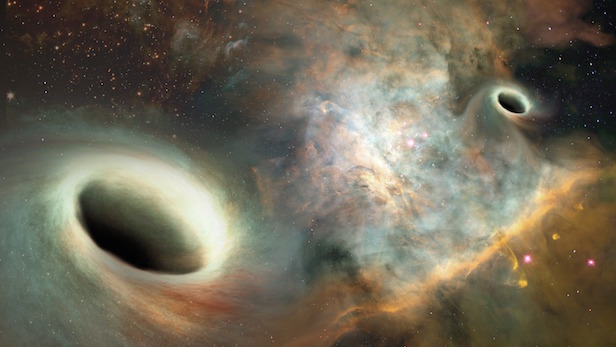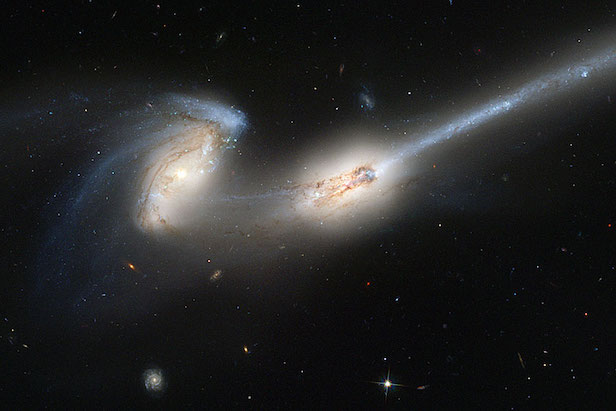Astronomers detect orbiting supermassive black holes
This detection of miniature orbital motion could be the missing evidence in the galaxy formation theory

This is an artist’s rendition of the two supermassive black holes in 0402+379, just 24 light years apart. Image credit: Josh Valenzuela/University of New Mexico
Since its discovery in 1995, astronomers have since used the National Science Foundation’s Very Long Baseline Array (VLBA) to monitor a pair of supermassive black holes. These observations have revealed the first, and miniscule, detection of orbital motion between two cosmic giants.
Some 750 million light years away is an elliptical galaxy named 0402+379. Astronomers have observed its two central supermassive black holes, which total a mass of 15 billion times the mass of our Sun, for over a decade. The pair also lie only 24 light years from each other, which is a very rare to have such gigantic stellar objects in this close proximity.
Since its discovery, the VLBA conducted observations in 2003 and 2005. More recently, Greg Taylor of the University of New Mexico, and his team combined new observations from 2009 and 2015 with the re-analysis of earlier VLBA data. The results confirmed that the two black holes are orbiting each other, with a single orbit taking 30,000 years.
The VLBA is a continent-wide radio telescope system, which utilises ten 25-metre diameter (82 feet) dish antennas spread out from Hawaii to St. Croix in the Caribbean. These radio dishes collaborate to produce a single telescope with the greatest resolving power available to astronomy. Roger W. Romani, professor of physics at Stanford, explains how diminutive the resolution of this orbit is: “If you imagine a snail on the recently discovered Earth-like planet orbiting Proxima Centauri – a bit over four light years away – moving at one centimetre a second, that’s the angular motion we’re resolving here.”

NGC 4676, or the Mice Galaxies, is in the extremely long process of merger, as gas, dust and stars are being thrown around due to the gravity of the two galactic monsters. Image credit: ACS Science & Engineering Team/HST/NASA
This discovery could be the missing link in the evolution of galaxy mergers. If there are two supermassive black holes in a binary system, it’s safe to say that this occurred from two galaxies colliding and eventually merging. There is photometric evidence of the beginning of a merger, shown by NGC 4676, also known as the Mice Galaxies. Current research has shown that gigantic amounts of energy can be released after a black hole amalgamation, and now this discovery could be the evidence for what happens in between these processes.
“We need to continue observing this galaxy to improve our understanding of the orbit, and of the masses of the black holes,” Taylor says. “This pair of black holes offers us our first chance to study how such systems interact.”
Keep up to date with the latest space news in All About Space – available every month for just £4.99. Alternatively you can subscribe here for a fraction of the price!




